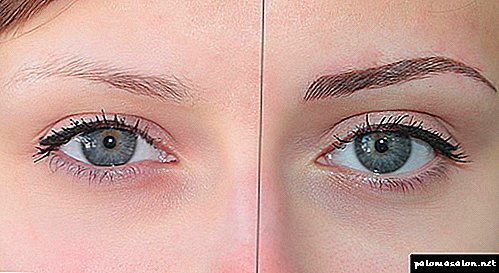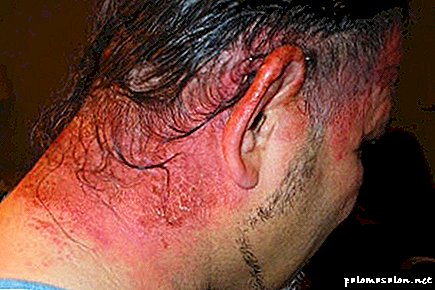According to various sources, a person can normally get 80-100 hairs per day without losing the density of the hair.
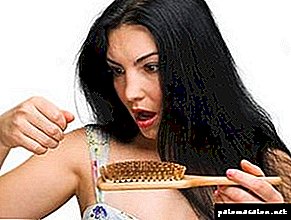 In fact, all the norms are conditional, since the life span of hair from the beginning of growth to loss in people differs by almost two times and is 3-5 years. And this means that the number of normal hairs per day will differ almost twice.
In fact, all the norms are conditional, since the life span of hair from the beginning of growth to loss in people differs by almost two times and is 3-5 years. And this means that the number of normal hairs per day will differ almost twice.
It should also be borne in mind that hair changes may occur unevenly depending on the seasons, errors in nutrition, diseases and other causes.
Often far more significant is the extent to which the number of newly appeared hair corresponds to the number of hair drained. Even if within a short time the hair fell out what is called a tuft, and after a week or two, a light fluff appeared on the parting, then we can assume that everything is normal: the body has experienced stress, but normal hair growth and hair density will not suffer.
 Usually, women pay attention to such increased hair loss without linking the fallout episode to a specific reason (tight diet, abrupt climate change, acute illness, etc.). If the cause is eliminated, they do not need any special care or treatment.
Usually, women pay attention to such increased hair loss without linking the fallout episode to a specific reason (tight diet, abrupt climate change, acute illness, etc.). If the cause is eliminated, they do not need any special care or treatment.
The hair that has now moved into the catagen phase (aging of the hair) will still fall out, and the growth of new ones will not be disturbed.
Another thing is when there are not so many per day, and new ones almost never appear. At first it will not be very noticeable, and will not cause concern to the owner of the locks, but later it will result in a pronounced decrease in hair density.
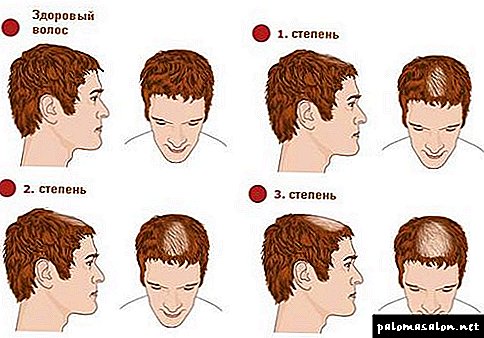 Photo: androgenetic type
Photo: androgenetic type
Usually this is typical for men with androgenetic alopecia, especially if its manifestation begins relatively late (after 40 years) and baldness progresses slowly.
In children, increased hair loss may have its own reasons specific to their age. This may be worms invasion, and fungal diseases of the scalp, and diseases of the gastrointestinal tract, and congenital total alopecia. Therefore, a pediatrician and a trichologist should deal with this problem.
Loss or breakage?
It is worth paying attention to such an important point, what are the hair that you see on a comb or in the bathroom. Is it a whole fallen hair? Or a broken hair tip, albeit a long one?
To find out, it is necessary to consider both ends of the hair. If on one of the tips there is a white rounded thickening, then this is the hair that fell out from the root.
If both tips are the same and there is no bulge on them, then the hair is simply broken off.
In the first case, suitable means to strengthen the hair against hair loss, and in the second means against brittle hair.
Video: Program - Balding
 Today, there are quite a few therapeutic drugs for baldness, designed to stimulate hair growth. Find out how effective baldness treatments are for men.
Today, there are quite a few therapeutic drugs for baldness, designed to stimulate hair growth. Find out how effective baldness treatments are for men.
Norm when washing
In order to find out if your rate of hair loss per day is exceeded, you need to select a day, and even better a few days, which will not be very busy with cases to calculate lost hair.
It should be remembered that lost hair is counted not earlier than the third or fourth day after shampooing. The fact is that the hair, which is ready to fall out, needs some provoking physical factor that will help them get out of the narrow mouth of the hair follicle. These factors are hair washing and combing.
When washing the figure is much larger than the rate of deposition when combing, and very much depends on how often you wash your hair.
The more often you wash your hair, the less hair you have with each wash. Accordingly, if you rarely wash your head, the amount of hair that has fallen out during one grooming procedure will be significant.
Also contributes to the loss of dead hair head massage, hairstyles, which are performed with a significant hair tension.

So, the number is counted on the third or fourth day after washing the head.
Video: How much hair should be falling out per day?
To do this, calculate:
- in the morning, those hairs that remained on the pillow and pajamas,
- hair that remains on the comb after each combing.
 The comb should not be a massage, but a regular one, with fairly frequent teeth. The sum of all the hair and is the number of hair loss per day. The work is very laborious and requires patience and time. But it's worth it if hair loss is important to you and it bothers you. It is possible that the amount of hair that has fallen out will be so small that you can calm down and switch to other tasks.
The comb should not be a massage, but a regular one, with fairly frequent teeth. The sum of all the hair and is the number of hair loss per day. The work is very laborious and requires patience and time. But it's worth it if hair loss is important to you and it bothers you. It is possible that the amount of hair that has fallen out will be so small that you can calm down and switch to other tasks.
This is especially useful for owners of long hair: the longer the hair, the more bulky they look on a comb. And it is quite possible that you do not have excess fallout, therefore there is nothing to worry about. The lack of information, the desire to have an attractive appearance, the abundance of advertising led to the fact that people began to think about this much more often than it actually needed. Hair loss is overgrown with a number of rumors and myths that we are now with you and consider.
Legends and Myths
- Legend is the first and my most beloved: Caffeine contained in coffee leads to a spasm of scalp vessels and provokes hair loss.
 Caffeine is found in coffee, black tea, and especially a lot of it in green tea. And he is part of a number of drugs, for example, in the same tsitramona, which many take as a remedy for headaches.
Caffeine is found in coffee, black tea, and especially a lot of it in green tea. And he is part of a number of drugs, for example, in the same tsitramona, which many take as a remedy for headaches.
This is how our cardiovascular system works, that drugs contained in the blood (and caffeine from coffee gets from the gastrointestinal tract into the blood) affect all the vessels of the body. And this means that caffeine cannot only spasm alone into the blood vessels that feed the hair. Likewise, it can be argued that teeth fall out from coffee, the retina suffers and nails fall off.
In fact, vascular spasm is important for hair loss, but this is already a result of the influence of the nervous system, for example, vascular spasm of the head can occur in response to stress, fear.
If the provoking factor arose only once, then there will be no harm to the hair and the whole body. If stress becomes chronic and the spasm of the blood vessels becomes permanent, then the condition of the hair will be disturbed.
- Legend Two: The longer the hair, the more difficult the hair follicle to hold them, because the longer the hair, the stronger they fall out.
There is no relationship between the length of the hair and the speed of hair loss. A significant reduction in hair density may be in individuals with short haircuts, if there are reasons for baldness. 
- Legend Three: shampoos, balms, ampoules help stop hair loss.
If you apply the above remedies for hair loss in combination with other activities aimed at identifying and eliminating the cause of baldness, the result will be. With abundant hair loss as a result of endocrine diseases and some other reasons, neither shampoos nor ampoules will help.
- Legend Four: Folk remedies are powerless in the treatment of baldness.
Well, here we must look at how balding we are dealing with. If a person has a persistent vascular spasm of the scalp against the background of constant stress, then the mustard mask will help him a lot if it is used regularly. If we are talking about androgenogenetic alopecia, then yes, decoctions and herbs will not help.
- Legend Five: Baldness can be cured.
Again, you need to look at what kind of baldness in question. If this is a diffuse alopecia, which is the result of a disease, a prolonged, rigid diet, permanent overwork, then such alopecia is treated with a complex of general-strengthening means and measures. If we are referring to nesting alopecia or androgenetic, then we are dealing with ordinary advertising promises. Do not fall for advertising promises. If the problem of hair loss bothers you, count the number of lost hair per day and feel free to contact the trichologist if you have such a need.
 Alopecia is a common disease, and in most cases occurs in young people. There are several types of this disease, one of them - alopecia areata.
Alopecia is a common disease, and in most cases occurs in young people. There are several types of this disease, one of them - alopecia areata.
How to prevent hair loss after childbirth? This question often worries young moms. Follow the link and find out how to stop baldness.
Hair loss during shampooing
If your hairstyle begins to thin out when you wash your hair, that is, when you wash your hair, you see about 100 hairs in the bathroom, then this is a signal to action! The rate of hair loss has already been completed, and still a whole day ahead. A very important step will at this time be in time to contact a trichologist. Otherwise, you will begin to go bald, and with baldness it will already be quite difficult to restore the old hair. At such times, you should use burdock oil, it has a very beneficial effect on the growth of new curls and prevents the loss of old ones.
It strengthens their roots. Apply it should be on the scalp 2-3 times a week and at least 30 minutes. Also important will be to eliminate all stress loads on the skin of your head. It will be necessary for a while to abandon the hair dye, all kinds of varnishes, curls and hair dryers, and then, later, to monitor how much hair you have when washing your hair.
Loss of thick hair after pregnancy
Losing a certain amount of hair after childbirth is normal. After all, the child takes a lot of nutrients from the mother's body. But over time, their growth returns to normal. Old hair, of course, already fall out, but new ones will grow remarkably further. However, not everyone has such a happy ending. Many young mommies complain that even after a year after pregnancy, the hair still thins and the tail on the head becomes very thin.
In this situation, you must take vitamins. For example, vitamin E, which, as we know, is a vitamin of youth. Such pills are sold in pharmacies, cost 10 rubles per pack. They are made on the basis of fish oil, but they are completely tasteless, as they are coated, so you will not feel any nasty taste.
Folk remedies
There are many folk remedies that can be prepared at home. They help to restore the hair structure, strengthen their roots, and have a beneficial effect on the scalp.
One of these tools, of course, can be called honey. Even in ancient times, people used this product to strengthen their hairstyles, and they had such chic and thick curls that the current beauties can only envy them. In order to apply a mask of honey, you need to do the following: put 2 tablespoons of honey to 1 l of water in boiled, but warm water, stir it all up and then apply on the hair roots 2-3 times a week. Hair from this will grow like yeast.
The usual table salt also strengthens the hair very well. It must be rubbed into the scalp after washing. It is necessary to massage for 10-15 minutes and repeat this procedure almost every day. The ancients believed that such a tool helps with baldness of dry scalp.
Still it is possible to use various broths of herbs. Here, for example, nettle has been considered grass from hair loss since ancient times. People took young nettles that did not burn yet, made a decoction from it, that is, they simply brewed it, and after washing their heads they rinsed their curls with it. And it is no coincidence that now there are many hair care products based on nettle broth or its extract. This tool really helps!
In conclusion, I would like to say that we are all different, someone has one remedy for strengthening hair, someone else is completely different. The main thing here is to start by consulting with a specialist so that it doesn’t happen that instead of helping yourself you only hurt your chic hairstyle.
The rate of hair loss per day in women
Healthy hair loss process is cyclical. Already in infancy, small hairs remain on the baby’s pillow.
Adults explain this phenomenon by the fact that the hairs are simply erased from the child while he is constantly lying down. In fact, already at this age balancing the number of hair folliclesin different stages.
All these stages 3:
- Anogen - active phase. During this period, the growth of the hair shaft occurs, about 1 cm per month and its pigmentation.
- Catogen - intermediate phase. There is a cessation of hair growth.
- Telogen - phase of falling or resting. The hair falls out.

Hair thinning becomes noticeable, and their loss is enhanced, when imbalance occurs between follicles in different stages.
Under the influence of various negative factors, the anogenic stage is reduced, and the telogen, on the contrary, lengthens. In the resting phase of the hairs, it is no longer 9%, but more, respectively, and much more will fall out.
Number of hair follicles on the head depends on the shape of the curls and ethnicity of a person.
Straight hair on the head is much more than curly and, especially, curly. Respectively, owners of straight smooth hair lose them in a much larger numberthan a woman with curly hair.
Determined the rate of hair loss per day in women with good health - from 50 to 100 pieces.
The rate of hair loss per day in women in the photo and a serious deviation from the norm:

The maximum number falls on women with light and straight strands of nature. Further, the rate of hair loss in women goes on decreasing: 80 - 90 hairs fall out of brunettes, and 50 - 70 in redheads.
Impact of external factors
In the spring, hair loss is somewhat enhanced, especially in residents in regions with a sharply continental climate. This process is associated with seasonal avitaminosis and stress, due to the influence of temperature fluctuations of the environment.

The process of falling out is affected various aggressive procedures - bleaching, highlighting, perm, frequent use of thermal devices (tongs, hair dryers). In these cases, the structure of the hair shaft is disrupted, that is, the hairs do not fall out from the root, but break off.
Many diseases can increase hair loss:
- seborrhea,
- endocrine disorders
- scleroderma,
- secondary syphilis,
- infectious diseases with severe febrile syndrome,
- ringworm,
The hairs in the telogen stage are usually removed as a result of light effort, therefore most of them remain on the comb, as well as after washing the head, especially if you used the balsam-rinse.
The fact is that the balm levels the structure of the hair shaft, making it smoother. Shampoo, on the contrary, opens the cuticle and the hair becomes as if fluffed. The open scales cling to each other, and the dropped hairs linger on the surface of the head.
Test for determination
Normal hair loss when combing should be with the amount of loose hairs no more than 15. If, however, to hold in a calm state along a separate strand with little effort, no more than 5 hairs should remain in the hand.
It is possible to differentiate temporary hair loss from alopecia if look at the root of a dropped hair.

In case of temporary loss the root is white, the rod itself is healthy and even. If the bulb is elongated, has a third-party shade, and the rod looks damaged, shortened or broken off - this indicates a disease associated with hair loss, or alopecia.
Temporary baldness women are more likely to be exposed than menand this is due to their physiological features, emotional and hormonal.
Among all women complaining of increased hair loss, in 95% of cases, telogen alopecia is diagnosed - temporary alopecia, provoked by stress, childbirth, hormonal contraceptives. Various negative emotions, experiences strongly affect the hair follicles, so the cause of hair loss in the first place should be sought in itself.
Hair cycle
The cells of our body are regularly updated. And hair is no exception. Just when we daily drop the skin in layers, it is completely unnoticed by the naked eye. But if to shift to the sun, the process becomes very intensive and active peeling begins. But you are not afraid that you will be left without skin ?!
Likewise, do not worry about the daily hair loss. They are usually replaced by new ones growing from the same follicles. Thus, our hair is constantly updated. And how much hair per day should fall out depends on the speed of this process, during which each hair passes through three phases:
 Anagenic (or active growth phase). During this period, the hair follicles work at full capacity, constantly producing new cells. The length of the rod increases with an average speed of up to 1.5 cm per month. And it happens for 2-5 years.
Anagenic (or active growth phase). During this period, the hair follicles work at full capacity, constantly producing new cells. The length of the rod increases with an average speed of up to 1.5 cm per month. And it happens for 2-5 years.- Catagenic (or phase of atrophic processes). It lasts about a month and during this time the hair papilla, through which the hair receives nourishment, will completely atrophy. The bulb slowly moves to the surface of the skin and keeps it weaker.
- Telogenous (or precipitation phase). Its duration also varies from a few weeks to 2-3 months. During her hair is still able to keep in place, but with the slightest mechanical impact, it is easily removed. It is the hair that is in the telogenic phase that we notice when washing and combing.
The most impressionable will be helped by less experienced statistics, which states that normally only up to 2% of the total number of hairs is in the catagenic phase at a time. In telogenic more - from 10 to 20%, and with age they can be up to 40%, since the processes of natural cell regeneration slow down.
Drop rates
Although scientifically established norms exist, in reality, how much hair falls out in a person per day depends on many factors:
- age and physical condition
- natural hair colors
- diet,
- lifestyle,
- having bad habits
- proper care for your hair,
- personal hygiene
- mental state, etc.
This is exactly the case when one size fits all, because even the numbers suggested by doctors vary within fairly wide limits. Moreover, they are somewhat different for men and women.
For men
 Men are more likely to notice lost hair when combing or when they are on clothes. Trichologists consider it permissible that a day from 100 to 150 hairs can fall out of a male head. Gradually, this number increases to 200, and after 50 years - to 250.
Men are more likely to notice lost hair when combing or when they are on clothes. Trichologists consider it permissible that a day from 100 to 150 hairs can fall out of a male head. Gradually, this number increases to 200, and after 50 years - to 250.
Alas, while no one is able to stop completely the age-related androgenic alopecia. It is considered a normal natural process.
Special attention experts advise men to pay for bald patches and bald spots. If they become more pronounced and slowly but surely increase in size, urgent measures should be taken to strengthen and / or restore the hair.
It is necessary to begin with a diagnosis, because if something causes the complete death of hair follicles, then the only way to renew hair in these areas will be their transplant.
For women
Women most often pay attention to lost hairs in the bath or shower. And this is not entirely correct. It is impossible to unequivocally say how much hair should fall out during normal washing of the head, since their number directly depends on the frequency of this procedure. If it is performed daily, then from 70 to 100 hairs can go “free swimming”. But if you wash your head every other day, or even two, then even a loss of 150-200 pieces cannot be considered critical.
It is all connected with the same phases of growth, about which we spoke at the beginning. Only those hairs that have actually died and are in the telogenous phase are “washed out”.
Women are usually combed much more carefully than men, for fear of damaging the hair structure. But wash your head carefully, realizing how important it is to clean the skin from impurities. Massage movements with the fingers help to unfix and pull out the dead hairs.
Causes of baldness
There are so many reasons that can provoke diffuse alopecia that it is simply impossible to list them all. Moreover, often several negative factors that can weaken or completely destroy the hair follicles simultaneously exert their negative influence.
Experts have identified the following types of alopecia:
 Infectious. In the presence of acute or systemic infections in the body, the hair will thaw necessarily, and at critical stages, much faster than during relapse. With full recovery, hair loss is inhibited, but hair restoration is not always possible. Usually hair falls out strongly in tuberculosis, AIDS, syphilis, malaria, pneumonia, meningitis.
Infectious. In the presence of acute or systemic infections in the body, the hair will thaw necessarily, and at critical stages, much faster than during relapse. With full recovery, hair loss is inhibited, but hair restoration is not always possible. Usually hair falls out strongly in tuberculosis, AIDS, syphilis, malaria, pneumonia, meningitis.- Androgenic. More than 40% of men and up to 20% of women are subject to it. Associated with a high content of male hormones in the blood, which leads to the active growth of hair on the face and body and the appearance of bald patches on the head. Amenable to adjustment by medication.
- Hormonal. It is associated with endocrine system pathologies or hormonal fluctuations caused by natural causes. Very thin hair in women before and after childbirth, as well as during menopause. Active hair loss may begin during adolescence. Push down and thin hairs of an infant after six months climb, replacing with denser and stronger ones.
- Medication. A vivid example is strong baldness after a course of chemotherapy. But alopecia can also be provoked by less aggressive drugs. Hair loss occurs with prolonged or regular use of beta-blockers, anticoagulants, anticonvulsants, and some other groups of drugs. Usually, the doctor warns about this in advance and this side effect is prescribed in the instructions.
- Deficient. It is observed when the body lacks vital nutrients to form a healthy hair or maintain a good condition of the skin and hair follicles. Baldness is often found in inexperienced vegetarians because of a deficiency of high-grade protein. Risk to spoil the hair and supporters of fasting or tough diets. Alopecia gradually develops in people with severe digestive problems.
- Psychosomatic. This form is increasingly common in our time in both women and men. They react differently to stress, but equally begin to lose hair during severe psycho-emotional or physical overload. In some cases, even a mental disorder develops, when a person, in order to calm himself down, begins to pull out his own curls.
- Seasonal. This is a completely normal transient process, which has a pronounced cyclical nature. After winter, seasonal alopecia is associated with a lack of sun and vitamins. And in early autumn, the hair is actively updated after the summer heat.
Doctors even have such a term as “idiopathic alopecia”, when the real causes of hair loss cannot be established even after a thorough diagnostic examination. Fortunately, there are few such cases and sometimes baldness in such patients stops with itself as suddenly as it began.
Effect of the procedures
Some hygienic or salon procedures may also affect the increase in the amount of lost hair. And often no one warns customers about this, and a baldness that suddenly starts causes a real shock to them. But it is not necessary to panic in all cases.
 Head massage. The procedure is pleasant and useful in all respects. But after the first sessions begin to actively climb hair. This skin breaks up with those of them that are in the telogenous phase. But under the mechanical action of the fingers, the process goes faster. You should not get upset - cell regeneration is activated, so healthy strong hair will soon grow back.
Head massage. The procedure is pleasant and useful in all respects. But after the first sessions begin to actively climb hair. This skin breaks up with those of them that are in the telogenous phase. But under the mechanical action of the fingers, the process goes faster. You should not get upset - cell regeneration is activated, so healthy strong hair will soon grow back.- Lamination, perm and dyeing. They spoil not only the structure of the hair shaft, but also have a negative effect on the condition of the skin and roots. Worst of all, when the composition falls on the dermis and is on it for a long time. After such procedures, it is necessary to do soothing and firming masks, as well as rinse your head after washing with decoction of healing herbs.
- Complicated hairstyles, including tight braids. All that for a long time keeps the hair in an unnatural position for them or causes their strong tension - is harmful and can cause baldness. Long curls often begin to fall out, which already create a greater load on the roots. Styling products also do not benefit them or the skin.
- Shave well. Many young men, who for a long time to create a more courageous and brutal image, shaved their heads baldly, and then were surprised to find that the once-thick head of hair had been irretrievably lost. The reason is simple - permanent skin microtraumas while shaving, as well as loosening of the roots during this procedure.
- Drying hair dryer. If this is done daily, moreover, using the highest possible temperatures, then the scalp is very dry. Over time, she begins to constantly peel off, get annoyed and thin. Hair follicles are in adverse conditions and weaken. As a result, the hair falls out more.
This does not mean that all the above procedures should be abandoned altogether. But you always need to know when to stop. To take care of a healthy strong hair is necessary not only with the help of masks and vitamins, but also ensuring her careful handling.
When it's time to worry
The fact that the process of hair loss is associated with some anomalies can be seen on certain grounds, in the presence of which it is better to consult a specialist:
- the number of hairs lost every day continues to increase - this indicates that alopecia is actively progressing,
 the root of the hair that has fallen out is not light, as usual, but a dark color - it may indicate fungal or other skin lesions,
the root of the hair that has fallen out is not light, as usual, but a dark color - it may indicate fungal or other skin lesions,- hair, on the contrary, ceased to fall out completely within a few days or even weeks - indicating that the renewal of hair is stopped,
- teenager complains of profuse baldness, which is accompanied by severe itching of the skin or other unpleasant sensations,
- when combing or if you just slightly pull a strand, a whole tuft of hair remains in your hand - obviously a pathological and very active balding process,
- loose hair is thin and does not have a root - an indicator of thinning and increased brittleness and the reasons are most likely in hot styling, sunlight, frequent dyeing or other external damaging effects.
Hair loss: normal or abnormal?
Hair grows over the entire surface of human skin, except for the soles and palms. Only because of the small thickness of them is almost invisible.
They contain keratin protein, which is produced by follicles in the outer layer of the dermis. Since the formation of new cells occurs constantly, the older ones go through the skin coating at a rate of about 15 cm per year. The hair that can be seen is actually keratin deposits.
On average, there are 100-150 thousand of them on their head, and about 100 fall out per day.
That is why a pair of hair remaining on the pillow does not have to be a cause for concern.
Approximately 90% of a person's scalp grows.
Each follicle has its own life cycle, depending on the age of the person, the presence of diseases and a large number of other conditions.
It can be divided into 3 periods:
- Anagen - the stage of active growth lasting from 2 to 6 years,
- catagen - transitional phase, lasting 2 - 3 weeks,
- telogen - a period of cessation of growth with a duration of 2-3 months, the completion of this stage is accompanied by loss of hair, it is replaced by a new one, and the cycle is repeated again.
With age, the growth rate slows down.

Causes of Fallout
Baldness happens for many reasons. With involutional alopecia, a natural phenomenon, when the hair gradually becomes thinner with age, an increasing number of follicles are at rest, and the remaining cover becomes smaller and shorter.
Androgenic alopecia is a hereditary disease that affects both sexes. Men begin to go bald already in adolescence. Characterized by a gradual decrease in hair from the crown to the frontal area of the head and the presence of bald patches. Alopecia in women does not appear until 40 years or longer. They have a general thinning of the cover over the entire head, with the most extensive loss in its upper part.
Local alopecia often begins spontaneously and is characterized by local hair loss in children. May result in complete baldness. But in about 90% of people suffering from this disease, the symptoms disappear after a few years.
Alopecia universalis causes baldness of the whole body, including eyebrows and eyelashes.
Telogen effifium - temporary thinning of hair due to a change in their growth cycle. At the same time a lot of follicles are at the stage of cessation of growth, as a result of which hair falls out and thin.
Cicatricial alopecia leads to permanent baldness. Inflammation of the skin (cellulitis, folliculitis, acne) and some forms of lupus erythematosus and red lichen often lead to scarring that impair the ability to regenerate. Hair dryers, curlers and too tightly woven and strapped hair can also cause balding.
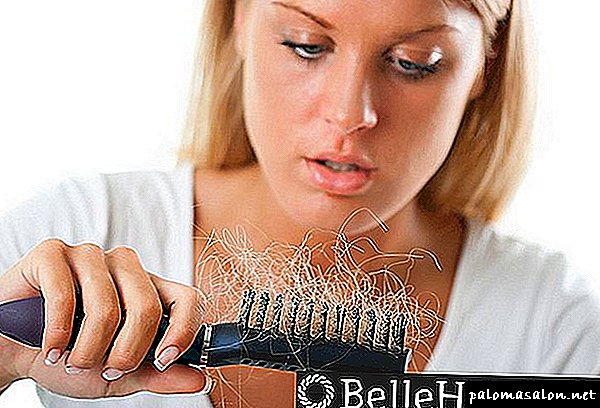
What is the amount of hair per day?
The rate of hair loss depends on their number. The more of them, the more they will fall out. On their head there are between 100 and 150 thousand. Often, people with red curls have a lower rate of hair loss, because, although they are thicker, they are smaller. The vegetation of blondes is fragile and thin, so the amount will be greater. Acceptable daily rate is in the range of 50 - 150.
What determines the number of lost hair?
Doctors can not yet say, because of what the duration of the growth phase of some follicles is less than that of others.
Nevertheless, factors that may influence this are known:
- increased levels of male sex hormones in both sexes,
- hereditary, i.e., propensity for baldness received from parents,
- nervous tension, illness, fungal infection and the birth of children can cause temporary baldness,
- medication, including chemotherapy, used to treat cancer, blood thinners, birth control pills, beta-blockers to control blood pressure also contributes to the renewable loss of hair,

- injuries, burns and radiation. Normal growth can resume if a scar does not form after the wound has healed. Otherwise they will not grow,
- cosmetic procedures - permanent perm, bleaching, dyeing - can contribute to the overall thinning of the hair, weakening and making it more brittle. Hair falls out during shampooing. Tightly weaving, stabbing, using curlers and cursings can also damage and break them. However, these procedures do not cause baldness. In most cases, after eliminating the cause of hair loss, they grow back. However, serious damage sometimes leads to the formation of irreversible bald patches,
- diseases of the pituitary gland, lupus, diabetes mellitus, anemia, disorders of the digestive tract and iron deficiency can also contribute to baldness. Predominantly, the cure of the underlying disease leads to renewed hair. An exception is scarring in some forms of lupus, lichen redness or follicular disorders,
- low-protein or low-calorie diet.
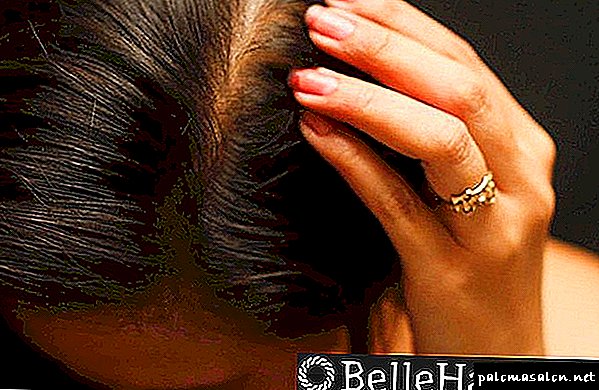
Ways to count
Standard assessment methods use the Ludwig and Norwood-Hamilton scales, but the best advice on how to calculate lost hair can be given only by the attending physician.
Non-invasive methods can be the following:
- daily collection of strands and counting them at the end of the day. On the day a person loses 100 hairs, and if the result exceeds this number, then there is a risk of baldness,
- determines the rate of hair loss during shampooing after a 5-day break,
- Photographing in a specially equipped doctor’s office. More precisely than previous methods.

Semi-invasive methods include:
- conducting a trichogram with sampling from certain areas of the scalp after 5-day use of a special shampoo,
- checking on the marked area of the scalp with tweezers and other instruments,
- biopsy scalp for suspected alopecia.
What affects the amount of lost hair?
Loss of hair is affected by many factors, both external and internal. After analyzing them, you can understand whether a certain amount is normal or not. When washing the head a lot of hair falls out, if you hold it once a week. With a daily procedure, losses are usually minimal.
In addition to hair loss when combing and washing, the age and thickness of the strands affect the pace of this process. The transition to the resting phase is also marked by strong baldness. Loss can be seasonal. But most often it is associated with any violations in the activity of the organism.
Causes of loss can be:
1. The use of poor-quality cosmetics for curls.
2. Bad ecology.
3. Sharp climate change.
4. Rough combing with ripping strands.
5. Temperature changes.
6. Lack of normal care.
7. Frequent strands of women in tight hairstyles.

8. Injuries to the scalp.
9. Violation of blood circulation, vasoconstriction.
10. Acceptance of certain drugs, contraceptives.
11. Hormonal disorders in women.
13. Reduced immunity.
14. Frequent dyeing, chemical perm.
15. Poor heredity, early baldness among parents. Mostly pathology occurs in men.
16. Aging of the body.
17. Recently suffered serious illnesses.
18. Improper nutrition.
19. Fungal and bacterial infections.
20. Ringworm.
22. Bad habits.
24. Surgical intervention.
25. Recent childbirth.
26. Deficiency of trace elements and vitamins, in particular, iron.
The symptoms of hair loss are severe thinning and significant loss of hair when combing or washing.

Fallen hair counting methods
In order not to panic in advance about the fact that baldness has begun, count the number of hairs that have dropped out. It is easiest to do this for women when combing and washing their heads.
There are several main ways:
1. At the end of the day, count the hairs left on the comb and in the bath after you wash your hair. It is also worth exploring the bed and pillow. To the resulting figure add 10-20, which could be lost on the street. If the result exceeds the rate of hair loss per day, then you should think about preventive measures to prevent baldness.
2. Grab a large bundle of curls with your fingers and hold down. If there are about 10 hairs in the palm - everything is fine, if there are more, then there is a loss. Perhaps you need to visit the trichologist.
3. They do not wash their hair for 3 days, and, on waking in the morning, they consider hairs found on the pillow and pajamas. After washing, the hairs in the drain hole are counted. Strands are dried by a hair dryer or naturally and combed with a wooden comb. Count the total. If the curls are long, then you can braid them in a braid, and before bedtime to dissolve and comb. Count the hairs and add them to the total. On the basis of these data, a dropout is ascertained.
After these tests, the conclusion is made about the presence or absence of baldness. If the amount exceeds the normal values, you should contact a specialist.

Recommendations for the prevention of baldness
These measures will help prevent hair loss and reduce daily hair loss:
1. With reduced immunity is to go in for sports and to establish a normal diet, enriching it with vitamins.
2. To improve blood circulation is useful to reduce the use of coffee, tea and alcohol.
3. Eat more fresh, unprocessed fruits and vegetables.
4. You need to deal with stress, get enough sleep and relax more.
5. For hair loss and baldness, folk remedies are used - masks, rinsing with herbs.
6. Do not wash your hair with hot water.
7. In order to identify the exact cause, you should contact the trichologist. Especially if there are problems with the scalp.
8. Carefully pick up the means with which they wash their heads.

9. When you drop can not abuse diets.
10. Enrich the diet with iron, the lack of which often causes precipitation. To do this, eat more apples, buckwheat porridge, liver, pomegranate juice and rye bread.
11. It is necessary to control the level of hemoglobin in the blood to avoid anemia.
12. Limit the use of a hair dryer, curling iron and ironing.
13. It is harmful to make hairstyles with a pile and a tight grip of the strands.
14. The head must be protected from wind, rain, frost and intense ultraviolet radiation.
15. With hair loss can not be used for coloring funds with ammonia.
Careful attention to changes in the state of curls will help maintain their health and beauty for a long time.
Optimal hair loss per day
Hair loss is a natural and mandatory process, as it is used to refresh them. If you see that hair remains on the brush or comb after combing, do not immediately panic. The main thing you should pay attention to is the number of hairs dropped out. The daily rate of hair loss in red - 70-90, and in blondes - 100-150.



In different literary sources, the same information is not always provided, but in general it can be said that normally a healthy person has between sixty and one hundred and fifty hair per day. Somewhat larger amount may fall out with a long combing from the roots and after washing.
What to do if hair loss per day is not normal?
Sometimes the amount of hair lost per day may vary due to climatic changes, the other common cause is vitamin deficiency. Due to the change of season, weather and many other things, hair may start to fall out stronger for a while. This is a common phenomenon, as after some time the hair adapts to new environmental conditions and falls out in accordance with the norm. But if you see that the rehabilitation of hair does not occur, but, on the contrary, the hair began to fall out even stronger, begin to sound the alarm. When massaging the head, after dyeing procedures or applying masks, a little more hair than usual is also lost. If the hair is then renewed, this is also normal. Therefore, do not panic ahead of time.
The first thing to do is to go to a specialist doctor. It is important to know the reason why the hair on your head began to fall out stronger than usual, since it is on this basis that the doctor will be able to prescribe you an effective course of treatment. If the reason is unknown, the specialist will direct you to take the necessary tests.
If you have avitaminosis, the problem with hair loss can be solved much faster, as in this case you can accurately determine the cause and eliminate its consequences. During avitaminosis (usually it appears in the winter-spring period), try to add more fruits and vegetables to your diet, as they contain a wealth of vitamins necessary for strengthening and restoring the hair follicle.
Also pay attention to hair care products. Try to use high-quality shampoos and balms, masks can be used at home. For hair dye, use preparations of a professional series or more benign products without ammonia. When using varnishes, mousses and other styling products, try to observe a sense of proportion.
Now you know how much lost hair per day can be considered the norm. Watch regularly for the health of your hair, treat it carefully, and then you will be able to preserve its beauty.

 Anagenic (or active growth phase). During this period, the hair follicles work at full capacity, constantly producing new cells. The length of the rod increases with an average speed of up to 1.5 cm per month. And it happens for 2-5 years.
Anagenic (or active growth phase). During this period, the hair follicles work at full capacity, constantly producing new cells. The length of the rod increases with an average speed of up to 1.5 cm per month. And it happens for 2-5 years. Infectious. In the presence of acute or systemic infections in the body, the hair will thaw necessarily, and at critical stages, much faster than during relapse. With full recovery, hair loss is inhibited, but hair restoration is not always possible. Usually hair falls out strongly in tuberculosis, AIDS, syphilis, malaria, pneumonia, meningitis.
Infectious. In the presence of acute or systemic infections in the body, the hair will thaw necessarily, and at critical stages, much faster than during relapse. With full recovery, hair loss is inhibited, but hair restoration is not always possible. Usually hair falls out strongly in tuberculosis, AIDS, syphilis, malaria, pneumonia, meningitis. Head massage. The procedure is pleasant and useful in all respects. But after the first sessions begin to actively climb hair. This skin breaks up with those of them that are in the telogenous phase. But under the mechanical action of the fingers, the process goes faster. You should not get upset - cell regeneration is activated, so healthy strong hair will soon grow back.
Head massage. The procedure is pleasant and useful in all respects. But after the first sessions begin to actively climb hair. This skin breaks up with those of them that are in the telogenous phase. But under the mechanical action of the fingers, the process goes faster. You should not get upset - cell regeneration is activated, so healthy strong hair will soon grow back. the root of the hair that has fallen out is not light, as usual, but a dark color - it may indicate fungal or other skin lesions,
the root of the hair that has fallen out is not light, as usual, but a dark color - it may indicate fungal or other skin lesions,